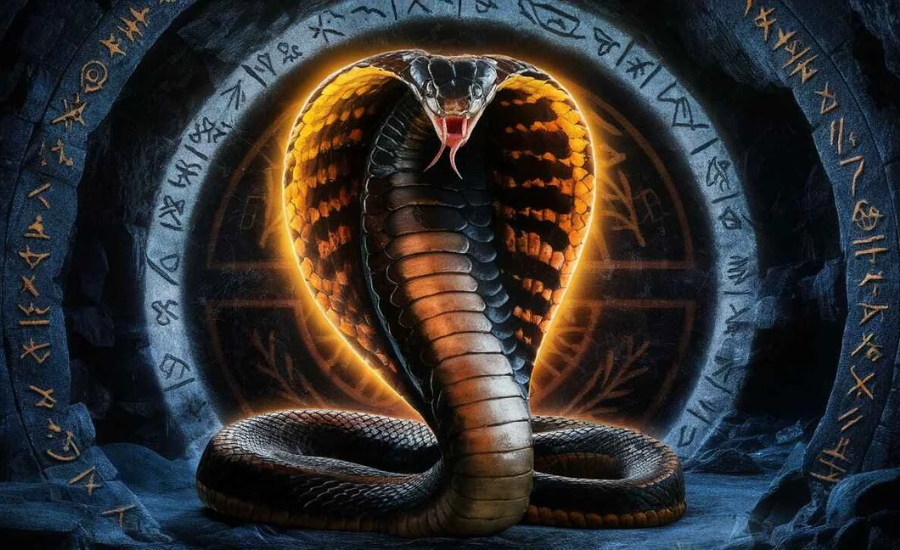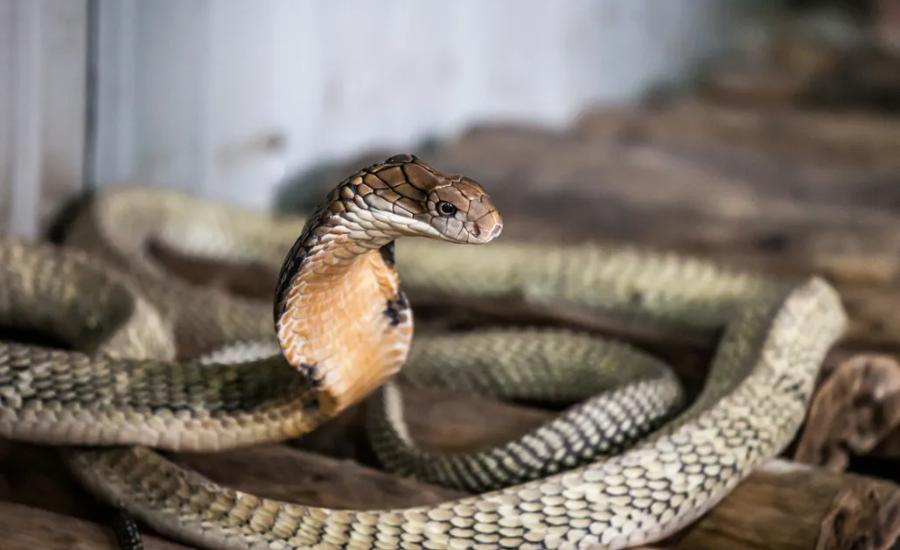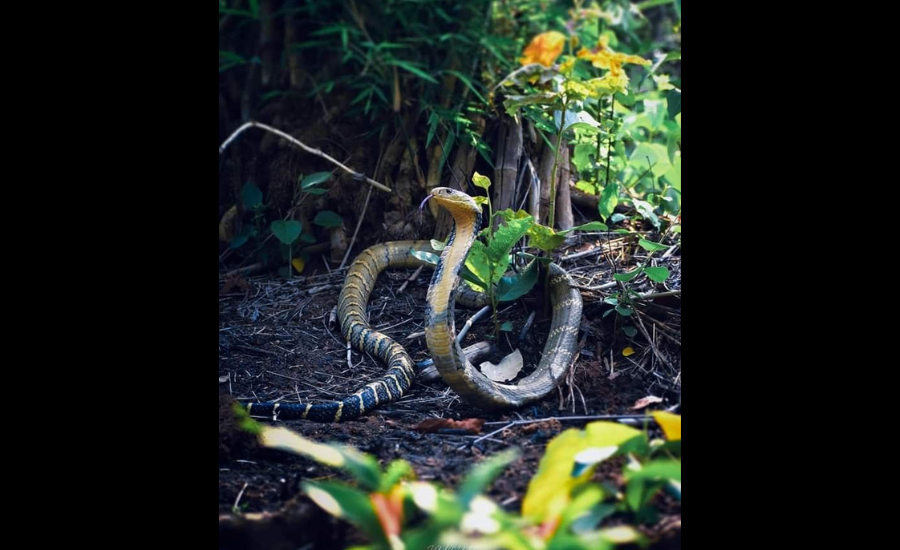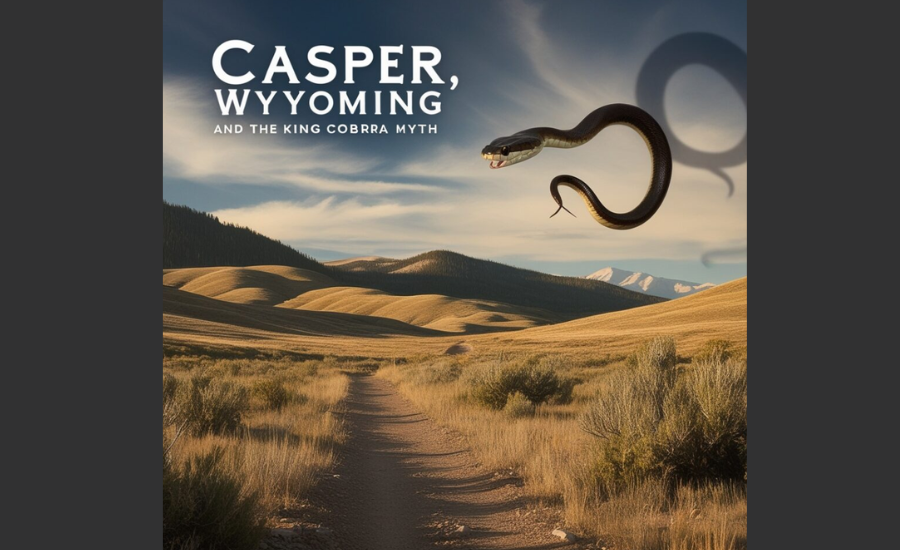The king cobra (Ophiophagus hannah) is a fearsome predator, capable of growing up to 18 feet and wielding venom strong enough to kill large animals, including elephants. Native to the tropical forests of South and Southeast Asia, these apex reptiles seem worlds away from the cold, dry climate of Casper Wyoming king cobras. Yet, Casper has cultivated an unexpected fascination with king cobras through conservation efforts, wildlife exhibitions, and educational programs. By showcasing these exotic snakes in local events, Casper Wyoming king cobras promote awareness about global biodiversity, sparking curiosity and advocacy. While conservation efforts for king cobras remain focused overseas, initiatives in Casper help foster respect for reptiles and contribute to a broader understanding of wildlife preservation, showing how even distant communities can play a role in protecting the natural world.
The Majestic King Cobra: A Symbol of Power and Precision

The king cobra, renowned as the world’s longest venomous snake, can grow up to an impressive 18 feet. Distinguished by its iconic hood and upright stance, this remarkable serpent flares its hood when threatened to warn potential dangers. Unlike most other venomous snakes, the king cobra primarily preys on other snakes, both venomous and non-venomous. Its genus name, Ophiophagus, meaning “snake-eater,” reflects this specialized diet.
Native to the lush forests, wetlands, and grasslands of Asia, these snakes possess sharp sensory abilities, including excellent vision and a keen sense of smell. Though venomous, king cobras are more defensive than aggressive, typically avoiding human encounters unless they feel provoked or trapped.
The Potency of King Cobra Venom
The venom of the casper wyoming king cobras contains powerful neurotoxins that disrupt the nervous system. In severe cases, it can cause muscle paralysis, respiratory failure, and death if left untreated. Despite their fearsome capabilities, king cobras prefer to avoid humans and strike only when they feel directly threatened or accidentally disturbed. With timely antivenom treatment, most bites can be managed, underscoring that these magnificent creatures are more cautious than hostile by nature.
Raising Awareness Through Education
Educational outreach programs in Casper play a key role in wildlife conservation, focusing on species like the king cobras in Casper, Wyoming as a way to foster greater understanding of global biodiversity. Although these snakes originate from Southeast Asia, showcasing them in public exhibitions serves as a tool to educate people about the importance of preserving reptile habitats around the world. Through interactive exhibits, wildlife centers emphasize how species like king cobras contribute to their native ecosystems and the challenges they face from habitat destruction and illegal wildlife trade.
These programs not only aim to reduce fear and misconceptions about snakes but also highlight the need for conservation efforts. Funds raised through these educational events often support global initiatives to protect the natural environments where king cobras thrive. By increasing public understanding and appreciation for reptiles, Casper’s wildlife organizations hope to promote a more positive attitude toward conservation and inspire action beyond the local community.
The Distinctive Behavior and Biology of King Cobras

The Casper Wyoming king cobras exemplify what makes these snakes so unique, with their specialized diet setting them apart from other cobras. While most cobras feed on small mammals, birds, and reptiles, king cobras focus almost exclusively on other snakes. Their diet includes non-venomous species, other venomous snakes, and even pythons, reinforcing their status as the “king” of snakes.
Intelligence and Defensive Displays
King cobras exhibit remarkable intelligence for reptiles. They are sensitive to vibrations and have excellent vision, capable of detecting prey from up to 100 meters away. When threatened, a king cobra will lift the front third of its body off the ground, spread its hood, and emit a loud hiss to intimidate potential predators or threats. This display often wards off danger without the need to strike, showcasing the cobra’s preference for defense over aggression.
Mating Rituals and Maternal Instinct
King cobra mating behavior is just as fascinating. During the breeding season, males compete through ritualistic wrestling matches to secure mating opportunities. Female king cobras exhibit a rare maternal instinct by building nests for their eggs and guarding them fiercely until they hatch. This protective behavior highlights their complexity, as most snake species do not care for their offspring after laying eggs.
The presence of Casper Wyoming king cobras in educational programs reflects not only a growing interest in exotic wildlife but also promotes awareness of these reptiles’ remarkable behaviors and ecological significance.
Casper, Wyoming: A Key Player in Raising Conservation Awareness
While Casper Wyoming king cobras may seem like an unusual combination, this city has become an unexpected ally in global conservation. Through reptile exhibitions and educational programs, Casper plays an important role in informing the public about the significance of species like king cobras in maintaining ecological balance. These initiatives go beyond entertainment, promoting understanding of the vital role reptiles play in their ecosystems and dispelling fears that often surround these misunderstood animals.
Casper’s involvement in reptile conservation has also fostered collaborations with international wildlife organizations working to safeguard king cobras in their native habitats. Through these partnerships, resources and funding are directed toward conservation projects in countries like India and Thailand, where efforts are focused on creating protected reserves and mitigating threats to endangered reptiles. These global connections demonstrate how even communities far from the natural habitats of king cobras can make a meaningful contribution to their survival, highlighting the importance of collective action in wildlife preservation.
King Cobras in Captivity: Meeting Their Unique Needs

Although Casper Wyoming king cobras are primarily seen in reptile exhibitions and wildlife programs, ensuring the well-being of these exotic snakes in captivity requires meticulous care. While Wyoming’s climate is unsuitable for a native population, conservation efforts and educational displays offer residents a chance to learn about these fascinating creatures.
Specialized Care and Handling
Creating a suitable captive environment for king cobras demands precision. These snakes need carefully regulated temperatures, humidity levels, and enough space to move and exhibit their natural behaviors. Since their diet mainly consists of other snakes, captive king cobras are fed species such as ratsnakes and non-venomous reptiles to replicate their wild diet. Handling them requires expert knowledge due to their highly toxic venom, with only trained herpetologists and reptile specialists managing their care to ensure safety.
Breeding Programs and Conservation Efforts
In some cases, king cobras in captivity are part of breeding programs aimed at preserving the species. These programs help maintain genetic diversity and create a buffer against declining wild populations caused by habitat loss. While not all captive-bred snakes are released into the wild, these efforts are essential in ensuring the species’ long-term survival and preventing further population declines.
Through exhibitions featuring Casper Wyoming king cobras, the community gains insight into the importance of conservation and responsible wildlife management, fostering a greater appreciation for these magnificent snakes and their role in global biodiversity.
Global Conservation Goals and Local Contributions
The long-term survival of king cobras hinges on sustained efforts to protect their native habitats in Asia, mitigate human-wildlife conflicts, and promote deeper understanding of their behavior and importance. These challenges demand international collaboration, but small-scale efforts, like those in Casper, are equally essential. Educational programs in Casper not only dispel common misconceptions but also inspire participants to support conservation initiatives beyond their borders.
By participating in global partnerships and hosting awareness campaigns, Casper serves as a model for other communities looking to contribute to wildlife conservation. Its involvement demonstrates that no matter how distant a community may seem from the species it seeks to protect, meaningful action is possible. The efforts made in places like Casper underscore the importance of local engagement in tackling global environmental challenges, proving that every contribution, no matter the scale, can make a difference.
Facts
Scientific Classification
- Common Name: King Cobra
- Scientific Name: Ophiophagus hannah
Physical Characteristics
- Length: Recognized as the longest venomous snake globally, capable of reaching lengths of up to 18 feet (approximately 5.5 meters).
- Venom Composition: Contains potent neurotoxins that can cause paralysis and, in severe cases, lead to respiratory failure or death in large mammals, including elephants, if not treated promptly.
Dietary Habits
- Primary Diet: Primarily feeds on other snakes, including both venomous species such as other cobras and non-venomous ones like pythons.
Natural Habitat
- Geographical Range: Inhabits tropical forests, wetlands, and grasslands across South and Southeast Asia, with significant populations found in countries like India, Thailand, Malaysia, and Indonesia.
- Behavior Towards Humans: Generally avoids human interaction, opting for flight when threatened or cornered.
Behavioral Traits and Defense Mechanisms
- Defensive Displays: When threatened, the king cobra raises the front third of its body off the ground, expands its iconic hood, and emits a loud hiss to deter potential threats.
- Sensory Abilities: Highly sensitive to vibrations and equipped with excellent eyesight, capable of detecting prey from distances of up to 100 meters.
Reproductive Behavior and Parental Care
- Mating Rituals: During the breeding season, male king cobras engage in ritual combat, wrestling with one another for the opportunity to mate.
- Maternal Behavior: Females exhibit rare maternal instincts by constructing nests and guarding their eggs until they hatch.
King Cobras in Captivity
- Care Requirements: Maintaining king cobras in captivity necessitates precise environmental controls, including appropriate temperatures, humidity, and sufficient space to replicate their natural behaviors.
- Diet in Captivity: They are typically fed other snakes, such as ratsnakes, to closely mimic their natural diet.
- Handling Protocols: Due to the high toxicity of their venom, only trained herpetologists and specialists are authorized to handle these snakes.
Conservation Efforts and Educational Outreach in Casper, Wyoming
- Awareness Initiatives: Casper promotes biodiversity awareness through various exhibitions and educational events centered around king cobras.
- Conservation Focus: Educational programs are designed to encourage respect for reptiles and foster global wildlife preservation efforts.
- Partnerships with Wildlife Organizations: The city collaborates with international conservation groups to protect habitats and combat illegal wildlife trade.
- Funding Contributions: Local initiatives help raise funds for conservation projects in regions like India and Thailand.
Challenges Facing King Cobras
- Habitat Degradation: Urban development, deforestation, and agricultural expansion pose significant threats to king cobra populations.
- Human-Wildlife Interactions: Increased encounters with humans are common as their natural habitats shrink.
- Wildlife Trade Risks: King cobras are often victims of illegal trade for their skins, venom, and use in traditional medicines.
Significance of Casper’s Conservation Initiatives
- Casper serves as a prime example of how even small or remote communities can play an essential role in global wildlife conservation.
- Educational events not only aim to dispel fears and misconceptions about snakes but also inspire individuals to support conservation efforts at local and international levels.
FAQs
Q: What are Casper’s connections to king cobras?
A: While king cobras are not indigenous to Wyoming, exhibitions and educational initiatives in Casper showcase these impressive snakes to enhance awareness of reptile conservation globally. These programs help the public grasp the ecological importance of king cobras, even though they are originally from Asia.
Q: Why are king cobras included in exhibits in Casper, Wyoming?
A: Casper actively promotes wildlife education through various reptile exhibitions, including those featuring king cobras. These events are designed to cultivate respect for reptiles, raise conservation awareness, and inspire advocacy for biodiversity on an international level.
Q: Is there a danger to the public from king cobras in Casper?
A: The king cobras exhibited in Casper are managed by trained professionals in safe and controlled settings. Although these snakes possess venom, public safety is prioritized, and strict protocols are in place to mitigate any risks during exhibitions and educational programs.
Q: In what ways does Casper aid king cobra conservation?
A: While conservation efforts for king cobras primarily focus on safeguarding their natural habitats in Asia, Casper plays a vital role by raising awareness through exhibitions and establishing partnerships with global wildlife organizations. These collaborations channel resources towards habitat preservation and other conservation initiatives.
Q: What do king cobras eat, and how is their diet managed in captivity?
A: King cobras are unique in their diet, primarily consuming other snakes, whether venomous or non-venomous. In captivity, care specialists ensure their diet closely resembles what they would eat in the wild to maintain their health. Handling and feeding these snakes require expertise due to their potent venom.
Q: How do Casper’s educational programs aid conservation efforts?
A: The educational programs in Casper aim to break down misconceptions about reptiles and foster a deeper appreciation for biodiversity. These initiatives emphasize the need to preserve snake habitats and motivate the public to engage in conservation efforts both locally and on a global scale.
Conclusion
The inclusion of king cobras in exhibitions and educational initiatives in casper wyoming king cobras, highlights the significant impact that even remote communities can have on global conservation efforts. While these magnificent snakes hail from the forests of Asia, Casper demonstrates the importance of public education in promoting awareness of biodiversity. Through local wildlife exhibits, the city not only raises consciousness about the ecological role of king cobras but also motivates advocacy that extends far beyond its borders.
Casper’s collaborations with international conservation organizations exemplify how local initiatives can support the preservation of endangered species. These partnerships effectively direct resources and funding toward safeguarding natural habitats in countries such as India and Thailand, showcasing the necessity of collective global action in conservation.
By bridging the gap between community engagement and international wildlife protection, Casper serves as a powerful example of how any town can contribute meaningfully to environmental stewardship. Through nurturing curiosity, dispelling myths, and promoting responsible conservation practices, the city plays a crucial role in safeguarding the planet’s biodiversity—one educational initiative at a time.
Stay in touch for more updates and alerts visit: BrookTaube!
